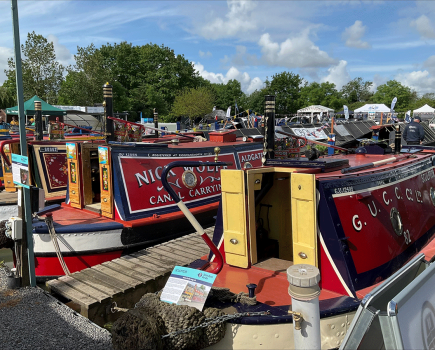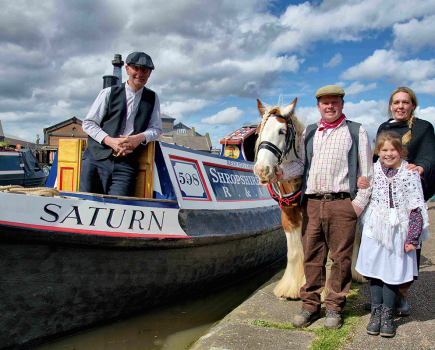Waterways campaigners and boating groups fear that the Union and Forth & Clyde canals could be slipping back into dereliction – but Scottish Canals says it’s working towards a sustainable future. So who’s right?

The Scottish Lowland canals were seen as one of the great success stories of the waterway restoration movement – and in terms of mileage and cost, the greatest achievement of the ‘Millennium Boom’ series of waterway openings. The Forth & Clyde Canal had been abandoned in the 1960s when the inconvenience of all the opening bridges was felt to outweigh its usefulness for getting small sea-going vessels from coast to coast (and inland pleasure boating had yet to catch on), while the Union Canal’s whose link to Edinburgh had been severed even earlier by the demolition of the connecting flight of locks near Falkirk. Following many years of campaigning and local revivals and reopenings by groups such as the Linlithgow Union Canal Society and the Forth & Clyde Canal Society, both canals were completed – including new road crossings, reinstement of filled-in sections, and diversions around obstructions – at a cost not far short of £100m thanks to the Millennium Fund, European and Scottish funding. The crowning achievement was the opening in 2002 of the remarkable Falkirk Wheel, the world’s only rotating boat lift and a new Scottish icon, at the heart of a reborn canal system which connected the country’s two greatest cities to its East and West coasts – and looked to have a bright future.
But just 16 years on, Scottish and UK waterways organisations are portraying a very different picture – of a canal system starved of cash by Scottish Canals (the Scottish Government body which took responsibility when English and Welsh waterways transferred to the Canal & River Trust), with numerous closures cause by failures of locks and bridges, uncontrolled weed growth and rubbish deterring boats, staff cuts severely limiting opening times (as all locks are operated by SC), and fears that the canal are slipping back towards the dereliction of the previous 40 years.
Is this an accurate summary of the state of the canals? There have certainly been some problems with them recently. Earlier this year the Inland Waterways Association highlighted two indefinite closures of power operated road liftbridges (Twechar and Bonnybridge) on the central section of the Forth & Clyde Canal, as a result of failure of mechanisms installed at the time of the reopening – with apparently no funds available for repairs. These were followed by failure of a traditional footpath liftbridge in western Glasgow, cutting off the navigable routes from the city to both the Forth and the Clyde. IWA wrote to SC, describing the closures as ‘unacceptable’.

A campaign group formed of 11 Scottish waterway organisations has taken this further. The Keep Canals Alive campaign, which includes canal societies, boat operators and boating organisations, has written to all seven local authorities on the route, calling on them to press SC to fulfil its obligations to keep the canals open.
The open letter was penned by Ronnie Rusack MBE, well-known Scottish canal supporter and leading light of the restoration campaigns for the Union and Forth & Clyde restorations. He said: “After 47 years of campaigning for the Lowland canals I’m not prepared to allow them to deteriorate any further”. Speaking on BBC Radio Scotland, he said “I’m frightened they’re going to close the canals: gradually run them down and close them. It’s getting bad. They’ve not been dredging. The maintenance has gone down all the time.”
In the letter, Keep Canals Alive highlights the closures, expresses fears of a threat to jobs in the hireboat operation and to canalside businesses, and says that SC “has not maintained the canals adequately”. The proportion of its budget spent on basic maintenance has fallen by one third, it adds, resulting in numerous failures, while staff cuts mean that some lengths are only open one day per week – and appear “virtually disused again”. Meanwhile, the letter says, none of the money that SC raises from canalside developments finds its way into the maintenance budget.

The letter points out that local councils paid £7.2m towards the restoration, and calls on them to press SC to adjust its budgets to meet its statutory maintenance responsibilities – not to stop investing in canalside developments, but to “realign priorities to ensure that the canals do not return to the dreadful state they were in before the Millennium. We are asking for a review of ne canal developments – some of which have new opening bridges – until SC is able to maintain the bridges it already has”.
In response, Falkirk Council was due to debate a motion supporting the campaign and calling on those who funded the reopenings to urge SC to comply with its obligations to keep the canals open. And the issue has reached the Scottish Government, with parliamentary questions tabled by the Conservatives, who reported that a freedom of information request had revealed that 35 holiday hireboat bookings had been cancelled so far this year, and expressed fears that tourism would suffer if the canals were “left to rot”.
But SC Chairman Andrew Thin countered that the canal was still open “to 99.9 per cent”, when counting all the users besides boaters, said that SC was “generating more self-earned income for reinvestment in the nation’s inland waterways than it receives in Grant In Aid from the Scottish Government”, and defended its Chief Executive Steve Dunlop from “being castigated for alleged failure” after “the bearings and hydraulics fail on a couple of 18-year-old mechanical bridges”. And a spokesman for SC said that “the vast majority of canal users, from runners and walkers to cyclists and kayakers, will be completely unaffected by these restrictions.”

Ronnie Rusack isn’t convinced by that. He quotes the Scottish Government’s own policy paper Making the most of Scotland’s Canals, which says “Boats add colour and interest to the canals. We wish to see further growth in the numbers of boats navigating our canals, and encourage both Scottish Canals, boaters and other parties to work together towards exploiting opportunities to achieve this.”
SC insists that “we are committed to bringing these bridges back into operation as quickly as possible”, and that “by generating our own income to reinvest in the canals, we are working towards a long term financially sustainable future”. However it also cautions that “with ageing assets, the impact of climate change and the increasing popularity of Scotland’s canals, we don’t have the money to do all we need to do” – adding that there is a £70m backlog of repair and maintenance work.
In the meantime, arrangements were made for the first restricted openings of the three affected liftbridges in early May for boaters needing to move their craft. But SC has made it clear that the state of the lifting gear means that in the case of Bonnybridge Bridge this is a one-off with no future openings until funds can be secured for full repair.
Image(s) provided by:
Martin Ludgate







